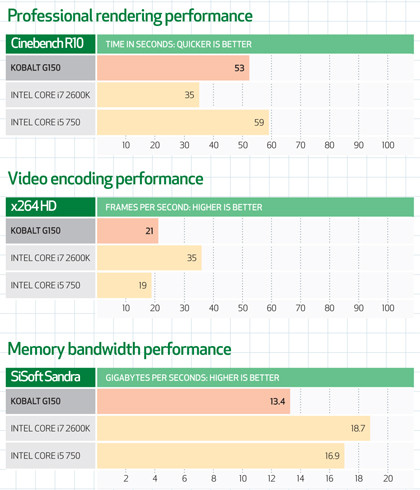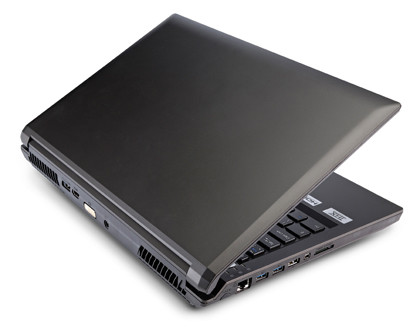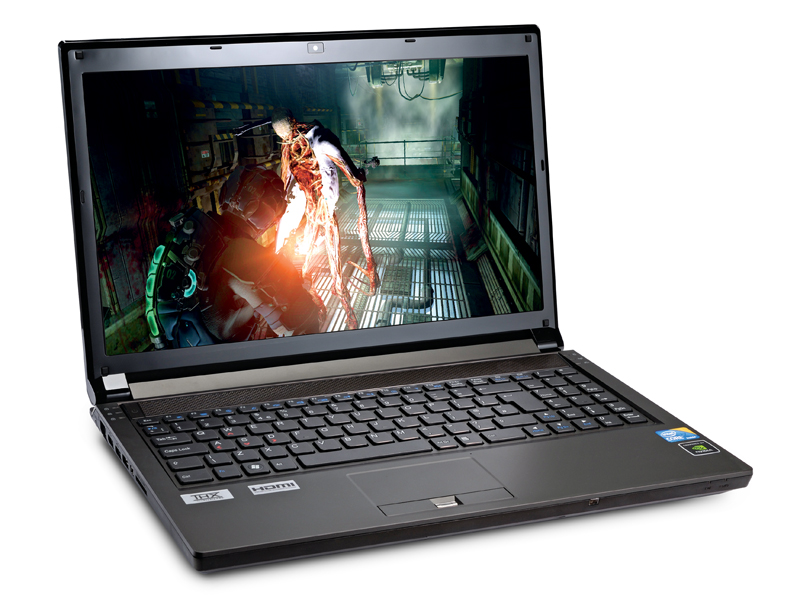TechRadar Verdict
Pros
- +
Ridiculous performance
- +
Great screen
- +
Moderately portable
Cons
- -
Pricey graphics options
Why you can trust TechRadar
From the get go, Intel's new Sandy Bridge family of PC processors have seemed destined for mobile greatness. Partly that's because Intel never intended the new Core i3, i5 and i7 2000 series chips to take over at the very top of the performance table.
That honour remains the reserve of the six-core Gulftown chip, if only just. But Sandy Bridge's status and the first pukka fusion processor for the PC is what really has us foaming over our flat panels.
The more components you integrate into the main processor die, the more powerful and space-efficient a chip becomes. With Sandy Bridge, Intel has now packed as many as four cores, the memory controller, graphics, PCI Express connectivity and more into a single slice of 32nm silicon. That spells mobile goodness.
As it turns out, the first Core i5 2500K and Core i7 2600K Sandy Bridge chips are much more effective on the desktop than we expected. In fact, they're bonkers quick. If the Sandy Bridge architecture is good enough to give a six-core Gulftown a scare on the desktop, just what kind of damage will it do in the mobile space?
First taste
Our first taste of Sandy Bridge architecture in a laptop comes courtesy of Kobalt's G150. On paper, it's pretty much our perfect portable. It's performance-oriented machine with serious gaming chops. But it's all squeezed into a tolerably portable 15.6-inch chassis.
Okay, it does have a massive power brick, which adds to the system's 3.1kg mass. So, it ain't exactly the sort of system you'd want to drag around on a daily basis. But nor is it a preposterously proportioned laptop with 17-inch-plus screen and a kerb weight to rival a small car.
Sign up for breaking news, reviews, opinion, top tech deals, and more.
Before we deep dive into the G150's tech specs, however, let's remind ourselves of what makes Intel's new Sandy Bridge chips tick and why they're so promising for notebooks. Actually, the CPU gubbins inside Intel's latest processor architecture are not radically different to those of existing Core i3, i5 and i7 processors, hewn as they are from the same 32nm production process.
Familiar features such as HyperThreading and Turbo Boost are largely carried over, as is the dual-channel DDR3 DRAM controller and support for memory frequencies up to 1,333MHz. Likewise, you have the same 16 channels of on-die PCI Express connectivity, which is good for wiring up a maximum of two GPUs via either AMD's Crossfire multi-GPU technology or SLI from Nvidia.
That said, there are several significant changes with the new chips. On the desktop, a change of socket is certainly significant as it precludes owners of existing Intel systems from drop-in upgrades. That's pretty much irrelevant for laptops which, for the most part, are not user-upgradeable.
Likewise, the new integrated clock generator isn't a major issue in portables. On the desktop it scuppers any chance of overclocking via the baseclock. But cranking up the clocks is impossible with most laptops.
More relevant for portable PCs is the overhaul Intel's given Turbo Boost. Depending on processor model, the difference between a mobile Sandy Bridge processor's base frequency and its maximum Turbo speed is a much as 1GHz. What's more, quad-core models are now among Intel's mainstream mobile chips.
The fastest is the Core i7 2920XM, which boasts a base frequency of 2.5GHz and a maximum Turbo or 3.5GHz. Of course, that top clock is only possible when a single core is active. But it's impressive nonetheless.
However, perhaps even more remarkable are the TDP numbers. The top 2920XM chip aside, all the quad-core models are rated at just 45 Watts. And remember, that power rating includes the on-die graphics.
Ah, yes, the integrated graphics core. In the desktop variants of Sandy Bridge, it's both the most intriguing and most infuriating aspect. The good news is that it makes much more sense in mobile form, even if one major flaw remains.
Full power
The key difference between mobile and desktop implementations of the new Intel HD Graphics core is that all laptop chips get the full power '3000' version with 12 execution cores.
As we saw in our reviews of the Core i5 2500K and Core i7 2600K, in 12-unit trim the new GPU is as good as it gets for integrated graphics. It's twice as fast as any similar GPU and is genuinely capable of light gameplay in older titles such as Call of Duty 4.
The mobile version of HD Graphics promises performance every bit as good thanks to clockspeeds that are only a whisker slower. The graphics core in laptop Sandy Bridgers runs at a maximum of 1,300MHz to the desktop's 1,350MHz.
However, arguably even better is the 2D video feature set. Some of the upgrades are incremental, such as the addition of an HDMI 1.4 interface and support for Blu-ray 3D. Likewise, the 2D video decode engine has been upgraded, with better hardware support for popular HD codecs including Flash video.
But undoubtedly the most exciting feature is a new video transcode engine known as Quick Sync Video. In desktop Sandy Bridge chips, it delivers anything from four to ten times the performance compared with recent CPU software encoding on dual- and quad-core Intel processors. Compared with mobile CPUs encoding in software, the performance delta promises to be even more dramatic.
The only snag is that the limitation that sometimes spoils Quick Sync Video on the desktop also applies to notebook PCs. You cannot use Quick Sync Video with a discrete graphics card.
Admittedly, you're less likely to be using a discrete graphics card in a laptop PC. Well, not unless you're serious about gaming. Which brings us neatly to a closer look at the Kobalt G150.
As a gaming oriented system, it doesn't just have a discrete 3D card. It has perhaps the most powerful of the lot, Nvidia's GeForce GTX 485M.
Strictly speaking, that moniker is a bit of a con. We're not talking about a mobile version of the GTX 485. Instead, it's the graphics chip otherwise known as GF104. Found in various desktop 3D boards, including the GTX 460 and new GTX 560Ti, this mobile variant has all 384 stream shaders switched on and the full 256-bit bus enabled.
The key difference is operating frequencies. The 485M clocks in at 575MHz core, 1,150MHz for the shaders and 750MHz for the 1GB of memory compared to the 560Ti's 822MHz, 1,644MHz and 1,002MHz. But it's still a monumentally fast mobile 3D chip, especially given the relatively compact proportions of the G150 chassis.
Benchmarks


This Kobalt system scores highly in other areas, too. The build is solid, with zero bounce or bend in the bed of the keyboard. Speaking of which, the whole top surface of its surround is covered in a thin rubberised film, which is intriguing to the touch even if it does attract bits of detritus.
Perhaps even better is the 15.6-inch LCD. Technically it's nothing special, based as it is on TN panel technology. But it does have an LED backlight and a glorious full-HD grid measuring 1,920 x 1,080 pixels. Thus, you get the same screen real estate as desktop monitors up to 24-inches in size.
What's more, it's a bright, vibrant panel with rich colours, decent viewing angles and good contrast. The latter is boosted by a glossy screen coating that may or may not be to your taste. It looks dramatic but also generates distracting reflections.
Specs appeal
Elsewhere, there's 6GB of DDR3 memory, a Blu-ray ROM and DVD burning drive along with good connectivity including HDMI, DVI and E-SATA. Various flavours of quad-core Sandy Bridge CPU are available.

Our test system has the base Core i7 2630QM model, rated at 2.0GHz with a maximum Turbo speed of 2.9GHz. In our testing it never clocked up beyond 2.6GHz. But that's hardly an issue.
We can only describe the performance of both the 2630QM and the GTX 485M graphics as utterly outrageous. Many a time has a laptop been described as offering desktop-replacement performance. The Kobalt G150 actually delivers.
In that context, we'd describe the battery life of just under two and a half hours when playing back 720p video as reasonable. All of which means this impressive system only has three problems.
The first is that you can't use that lightning-fast Quick Sync Video transcoder core. That's a real bummer, both because of the awesome performance it offers and because you've effectively paid for a feature you can't use.
Next up is the hard drive. At 500GB, it's capacious. But it's also a traditional magnetic drive with a spinning platter, and in this age of SSDs it feels dog slow. Kobalt offers a Crucial C300 128GB SSD for £153. That's an upgrade box we'd tick.
Finally, there's the minor matter of money. The killer here is that GTX 485M graphics is a £381 upgrade option. That's right, nearly £400 for a lower clocked version of a card that goes for £200 in desktop trim.
All told, it makes for a system that just breaches the £1,700 barrier. That's a whole hill of money. But if you want the best, you have to pay for it. If you can afford it, we doubt the Kobalt G150 will disappoint you.
Follow TechRadar Reviews on Twitter: http://twitter.com/techradarreview
Technology and cars. Increasingly the twain shall meet. Which is handy, because Jeremy (Twitter) is addicted to both. Long-time tech journalist, former editor of iCar magazine and incumbent car guru for T3 magazine, Jeremy reckons in-car technology is about to go thermonuclear. No, not exploding cars. That would be silly. And dangerous. But rather an explosive period of unprecedented innovation. Enjoy the ride.
